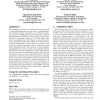IJCAI
2007
15 years 1 months ago
2007
Dimensionality reduction is a much-studied task in machine learning in which high-dimensional data is mapped, possibly via a non-linear transformation, onto a low-dimensional mani...
83
Voted
SDM
2010
SIAM
15 years 1 months ago
2010
SIAM
The dimensionality reduction problem has been widely studied in the database literature because of its application for concise data representation in a variety of database applica...
AAAI
2010
15 years 1 months ago
2010
Multi-instance learning deals with problems that treat bags of instances as training examples. In single-instance learning problems, dimensionality reduction is an essential step ...
131
click to vote
AAAI
2010
15 years 1 months ago
2010
Dimensionality reduction is the process by which a set of data points in a higher dimensional space are mapped to a lower dimension while maintaining certain properties of these p...
141
click to vote
CIVR
2008
Springer
15 years 2 months ago
2008
Springer
Since the emergence of extensive multimedia data, feature fusion has been more and more important for image and video retrieval, indexing and annotation. Existing feature fusion t...
102
click to vote
CBMS
2005
IEEE
15 years 2 months ago
2005
IEEE
Inductive learning systems have been successfully applied in a number of medical domains. Nevertheless, the effective use of these systems requires data preprocessing before apply...
105
Voted
KDD
2010
ACM
15 years 2 months ago
2010
ACM
Dimensionality reduction plays an important role in many data mining applications involving high-dimensional data. Many existing dimensionality reduction techniques can be formula...
121
click to vote
ADMA
2008
Springer
15 years 2 months ago
2008
Springer
We investigate the effects of dimensionality reduction using different techniques and different dimensions on six two-class data sets with numerical attributes as pre-processing fo...
101
click to vote
ACMACE
2008
ACM
15 years 2 months ago
2008
ACM
Dimensionality reduction is a statistical tool commonly used to map high-dimensional data into lower a dimensionality. The transformed data is typically more suitable for regressi...
104
Voted
AAAI
2007
15 years 2 months ago
2007
Recently the problem of dimensionality reduction has received a lot of interests in many fields of information processing. We consider the case where data is sampled from a low d...








